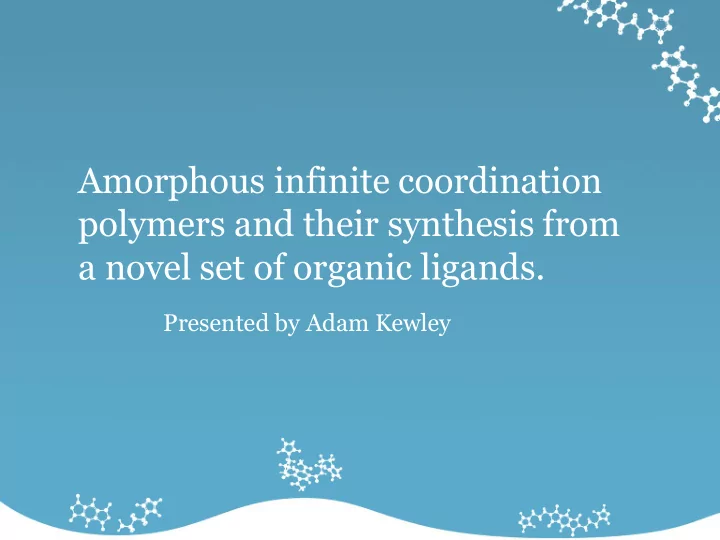

Amorphous infinite coordination polymers and their synthesis from a novel set of organic ligands. Presented by Adam Kewley
Content • Background • Synthesis • Characterization • Conclusion
Metal organic frameworks (MOFs) Framework made from single metal ions and rigid organic ligands ( linkers ) to make a one- two- or three-dimensional framework that can be porous. • Chemically tailorable • Wide range of uses brought on by the porosity 1
MOFs ( cont. ) Applications: • Catalysis Industrially, commercially, • Separation and scientifically interesting. • Storage The major disadvantage: • Solution based behaviour Difficult to produce industrially large quantities. Difficult to crystallize in some cases and therefore hard to characterize etc.
Infinite coordination polymers (ICPs) A polymer created from the coordination between metal ions and multidentate ligands to create an “infinite” framework. • Amorphous • Can be made into stable particles by precipitation Good solution behaviour • • Can encapsulate other species 2
Synthesis: Ligands “ L1 ” • Reflux both reactants in DMF, filter, wash with DMF, and recrystallize from DMF/EtOH. Characterized by 13 C-NMR & single-crystal XRD. •
Synthesis: Ligands L1 (MeCN) R=15%
Synthesis: Ligands “ L1 ” “ L3 ” • Refluxed L1 in acetic acid, evaporated, precipitated the resulting oil, recrystallized in water. • Characterized by 13 C, and FTIR
Synthesis: Ligands “ L3 ” • Reactants refluxed in THF, filtered, THF washed, recrystallized (CHCl3/EtOH). • Characterized by ES-MS, 1 H-NMR, Elemental analysis
Synthesis: Ligands 3 L3 R=10%
Synthesis: ICPs Stir the metal salt and ligand in solution, centrifuge, decant, dry • (vacuum/N 2 ) • Stable, dispersible, particles • Characterized by FTIR, single-crystal XRD, and AFM
ICPs: Characterization FTIR: L1 Metal coordinated Assignment Literature value 4 (unsubst.) Uncoordinated L1 Co II Cu II Mn II Zn II Co II Cu II Mn II Zn II (ref) (ref) (ref) (ref) C=O str. N/A 1644 1621 1634 1622 1632 N/A N/A N/A N/A Ring str. 1509 1474 1465 1490 1465 1489 1527 1533 1524 1531 Ring str. 1486 1368 1404 1404 1403 1401 1498 1507 1495 1506 Ring str. 1359 1345 1363 1384 1362 1384 1370 1374 1368 1372 Ring str. 1323 1316 1337 1342 1337 1340 1325 1333 1323 1330 FTIR: L2 Metal Coordinated Assignment Literature value 4 (unsubst.) Uncoordinated L2 Co II Cu II Mn II Zn II Co II Cu II Mn II Zn II (ref) (ref) (ref) (ref) C=O str. N/A 1654 1663 N/A 1662 N/A 1654 N/A 1667 N/A Ring str. 1509 1509 1522 1523 1519 1528 1527 1533 1524 1531 Ring str. 1486 1456 1456 1456 1455 1455 1498 1507 1495 1506 Ring str. 1359 1375 1384 1384 1384 1384 1370 1374 1368 1372 Ring str. 1323 1345 1342 1341 1341 1342 1325 1333 1323 1330
ICPs: Characterization L1 Zn II ICP (MeCN) R=15%
References R=15%
ICPs: Characterization L1 Zn II ICP a c 5.46A b
ICPs: Characterization All spherical, aggregates • • Varying particle sizes for each reaction (3-45nm sizes) • Possible solvent and temperature dependence observed (growth mech. considerations)
Growth mech 5
Conclusions Experimentally • Ligand synthesis appeared to be successful • The resulting ICP particles appeared to be composed of coordinated metal-ligand compound XRD shown a potentially interesting MOF structure • Overall • ICPs have a large amount of industrially applicable potential • Some hurdles in synthesis, mechanism to overcome
References 1 Mohamed Eddaoudi, David B. Moler, Hailian Li, Banglin Chen, Theresa M. Reineke, Michael O'Keeffe, and Omar M. Yaghi, J. Am. Chem. Soc . 2007, 34, 319 2 Champness, N. R. Angew. Chem.-Int. Edit. 2009, 48 , 2274 3 V. J. Richards and N. Champness, previous research on the ligands 4 Carlson, R. H.; Brown, T. L. Inorg. Chem. 1966, 5 , 268. 5 Spokoyny, A. M.; Kim, D.; Sumrein, A.; Mirkin, C. A. Chem. Soc. Rev. 2009, 38 , 1218.
Recommend
More recommend